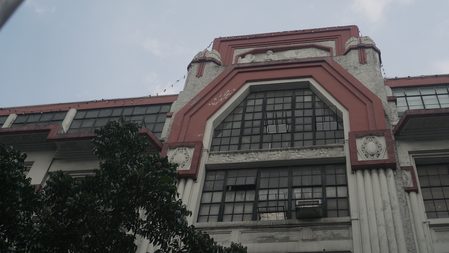SUMMARY
This is AI generated summarization, which may have errors. For context, always refer to the full article.
![[The Slingshot] When heritage’s wrecking ball comes from the National Museum](https://www.rappler.com/tachyon/2023/06/tl-wrecking-ball-natl-museum.jpg)
It is a gross aberration when government’s national cultural agency, mandated to be a prime heritage protector of the State, becomes the demolition team itself. In which case, not just alarm bells but danger signals are now forewarning us of what else it could do to our continually depleting national heritage.
The Relief Map of the Philippines and lagoon at the eastern end of the Rizal Park is no more. It was demolished by the National Museum of the Philippines (NMP). It is now all rubble. The agency has not even announced it on its official website or on any of its social media accounts.
NMP Director General Jeremy Barns was invited on air last June 1 on TV5’s The Big Story, and immediately there was no doubt that he incriminated himself. First, he said that Republic Act 10066 or the National Cultural Heritage Act of 2009 did not cover the Relief Map. Secondly he said that it was not declared a historical or heritage site. Thirdly, he said the map was not the work of a National Artist, hence not meriting automatic declaration. Fourthly, he said it had no historical marker. Finally he said the Relief Map has been an icon of 40 years.
Let us pit his arguments against the law. Thanks to digital publication, the hyperlinks are provided for the reader to peruse. For a site to be considered historical or heritage, RA 10066’s Section 5 on Cultural Property Considered Important Cultural Property (ICP) makes the following criteria, as applicable to a built heritage such as the site in question:
First, it must be the work by a Manlilikha ng Bayan or a National Artist. The Relief Map fails that criterion. Second, if the site is a Marked Structure, meaning it has the fabricated steel marker of the National Historical Commission of the Philippines, it is automatically an ICP. Again, the Relief Map fails that criterion. Barring those criteria, the law also stipulates very clearly: structures dating at least 50 years old are ICP.
Barns said the fundamental basis for the demolition was Republic Act 11333 or the National Museum of the Philippines Act of 2018 that was the impetus for the agency to make a long-term plan, including building a new exhibition hall over the site of what used to be the Relief Map. This law mentions the Burnham Plan of 1905. That is quite odd because Burnham wanted a National Congress building on that site.
In Section 6 of that law, the eastern section of the Rizal Park is now appropriated to the National Museum of the Philippines to form what it calls the National Museum Complex. This includes the old Congress building (National Museum of Fine Arts), the old Department of Finance building (National Museum of Anthropology), the old Department of Tourism building (formerly Department of Agriculture, National Museum of Natural History), the National Planetarium, “and their associated lands.”
Let’s leave Section 6 momentarily and return to Barns’s statement that the Relief Map is not a declared historical site. This is one of his most serious errors. In fact, the entire Rizal Park is listed as a Level I National Historical Site in the Philippine Registry of Cultural Property (PRECUP) on Built Heritage. Its inclusion in the PRECUP is by virtue of a declaration by the then National Historical Institute through NHI Resolution No. 7 Series of 1995 as a National Historical Site.
When RA 11333 appropriated the eastern section of Rizal Park to the NMP, it was silent on the NHI Resolution. It did not expressly repeal the declaration for that part of the Rizal Park. Therefore that resolution stays. The Relief Map falls inside a declared National Historical Site. Section 8 (Dedication of the National Museum Complex to Dr. Jose Rizal) of RA 11333 in fact affirms that: “it is a part of Rizal Park.”
The reader can peruse other sources of the PRECUP such as that of heritage advocate Ivan Henares and the NHCP Historic Sites Blogspot. The Rizal Park is a declared National Historical Site.
Where Barns and the National Museum err terribly is the age of the Relief Map and the sculptor behind it. In 1967 to 1969, the newsman Teodoro Valencia, then the head of the National Parks Development Committee that administers Rizal Park, commissioned sculptor Jose M. Mendoza to mount several public art works as part of the park’s attractions. These were the carabao and tamaraw across the National Flagpole, the collaborated sculpture Bisig which won the Art Association of the Philippines competition in 1968, and other works – the Janus, the Children’s Playground, and the Garden for the Blind scattered around Rizal Park.
His biggest work, however, was the giant Relief Map of the Philippines, which was done at a cost of almost a million pesos and took nine months to complete. Mendoza wanted a meticulous attention to detail that even Mayon Volcano was designed to emit smoke. After that, Valencia rewarded him with a six-month trip around the world to study international exhibitions, including an apprenticeship with Elden Keft at the University of Kansas where he developed expertise on ceramic shell casting.
Jose M. Mendoza was not actually an unknown in Philippine art. For years, he was under the patronage of the Zobel de Ayalas of Makati, the reason why Mendoza sculptures grace many of the business district’s avenues: Gabriela Silang (Ayala Avenue), Pio del Pilar (Paseo de Roxas), Sultan Kudarat (Makati Avenue), Bataan Memorial (Ayala Triangle), Tug-of-War (fronting the then Manila Intercontinental Hotel), and Risen Christ (Magallanes Village church). These were mostly done in the classical style using the technique of cire-perdue (lost wax method). After graduation from the University of Santo Tomas, Mendoza apprenticed under the National Artist for Sculpture Napoleon V. Abueva. He was not a pygmy in the Philippine art world. One son, Jordan Mendoza, is also a sculptor and has exhibited at the Ayala Museum.
Mendoza’s Relief Map of the Philippines was at least 54 years old. It fits the criteria for an Important Cultural Property. RA 10066, contrary to Barns’ reasoning, covers it.
Lawyer and archaeologist Kathleen dela Cuesta Tantuico, who specialized in Cultural Heritage and History at the Ateneo de Manila and who was a member of the National Committee on Monuments and Sites of the NCCA, states it very enlighteningly: “Even unmarked historical structures are protected by the law. Structures that are at least 50 years old are presumed as Important Cultural Properties, and can be officially declared and marked as such later on. Numerous unmarked Spanish-era historical structures have been spared from destruction, thanks to this provision.” In the case of the Relief Map, there is no need for a heritage marker. Barns uses that as an alibi, but he is clearly refuted by the law.
To demolish an ICP, RA 10066 requires a delisting or if a presumed ICP because of age, lifting of the presumption. To do that, a petition is addressed to the National Commission for Culture and the Arts (NCCA). It then calls for a hearing of the stakeholders, who can be any one. Position papers are required and the NMP could have been given 15 days to respond. None of that happened because NMP did not elevate the matter to the board of the NCCA.
The archaeologist Eliza Romualdez Valtos, who has written her opposition to the demolition, observed that the demolition first began in April this year with the initial destruction of Palawan. That indicates that as late as April 2023, NMP did not even inform the NCCA. It broke the law, plain and simple.
The top conservation architect and UP architecture professor Gerard Lico articulates the Relief Map’s cultural significance: “The nation is invisible. It must be made tangible so that its citizens can profess their love for this national imagination. Lamentably, it died a swift and silent death without the benefit of a public discourse.”
The National Museum of the Philippines committed a travesty of the law. Its top officials, including Barns, should now be investigated for possible criminal or civil action and face suspension while investigated. Will it even publicly apologize to Jose M. Mendoza?
Our heritage laws are observed more in the breach. It is time to give it teeth. – Rappler.com
Antonio J. Montalván II is a social anthropologist who advocates that keeping quiet when things go wrong is the mentality of a slave, not a good citizen.
Add a comment
How does this make you feel?



![[WATCH] #TheLeaderIWant: Filipino voters sound off on community issues a year before 2025 elections](https://www.rappler.com/tachyon/2024/05/filipino-voters-sound-off-on-community-issues-1.jpg?resize=257%2C257&crop=276px%2C0px%2C720px%2C720px)







There are no comments yet. Add your comment to start the conversation.